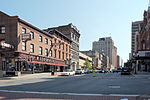St. Peter's Episcopal Church (Albany, New York)

St. Peter's Episcopal Church, also known as St. Peter's Church, is located in downtown Albany, New York, United States. It was designed in the mid-19th century by Richard Upjohn and his son Richard M. Upjohn in the French Gothic Revival architectural style. It was listed on the National Register of Historic Places in 1972, and designated a National Historic Landmark eight years later. It is also a contributing property to the Downtown Albany Historic District. The church was established at the behest of Queen Anne in 1715. The church still has a silver communion service set given to it by her. It was the first Anglican congregation north of New York City and west of the Hudson River. A building was erected shortly after the church was established, housing it for the rest of the 18th century. In 1758, George Howe, 3rd Viscount Howe, was buried here after his death leading an attempt to recapture Fort Ticonderoga during the French and Indian War. His grave remains in the current church, making him the only British peer buried in the United States. The original building was replaced in 1803. That building yielded to the current structure almost 60 years later, with the tower making it complete in 1876. It is often considered one of the elder Upjohn's best-known works, although his son was largely responsible for designing the tower, its most distinctive feature. The interior includes some original Clayton & Bell stained glass windows and sculpture by Louis Saint-Gaudens.
Excerpt from the Wikipedia article St. Peter's Episcopal Church (Albany, New York) (License: CC BY-SA 3.0, Authors, Images).St. Peter's Episcopal Church (Albany, New York)
Lodge Street, City of Albany
Geographical coordinates (GPS) Address Nearby Places Show on map
Geographical coordinates (GPS)
| Latitude | Longitude |
|---|---|
| N 42.650833333333 ° | E -73.753888888889 ° |
Address
Lodge St & State St - Hilton
Lodge Street
12207 City of Albany
New York, United States
Open on Google Maps










